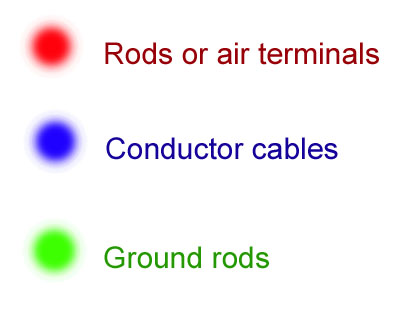Currently, the lightning conductor refers to all a protection system designed to protect people from the lightning, so the real lightning rod is only a small part of a complete lightning protection system. In fact, the rods may play the least important role in a system installation. A lightning protection system is composed of three main components:
![]() Rods or air terminals: Rods can be found in different shapes, sizes and designs. Most are topped with a tall, pointed needle or a smooth polished sphere. The functionality of different types of lightning rods, and even the necessity of rods are subjects of many scientific debates.
Rods or air terminals: Rods can be found in different shapes, sizes and designs. Most are topped with a tall, pointed needle or a smooth polished sphere. The functionality of different types of lightning rods, and even the necessity of rods are subjects of many scientific debates.
![]() Conductor cables: These heavy cables are made of copper or aluminum. They connect air terminals to the grounds cables and carry lightning current from the rods to the ground. Cables are run along the tops and around the limits of roofs, then down one or more corners of a building to the ground rod(s).
Conductor cables: These heavy cables are made of copper or aluminum. They connect air terminals to the grounds cables and carry lightning current from the rods to the ground. Cables are run along the tops and around the limits of roofs, then down one or more corners of a building to the ground rod(s).
![]() Ground rods or protection grounds: Long, heavy rods buried deep into the earth, around a protected structure. Main conductors are set at least 300 meters deep in the earth and are attached to metal grounding rods. Special requirements are sometimes necessary in sandy or rocky soil. The conductor cables are connected to these rods to complete a safe path for a lightning discharge around a structure. The energy is directed into the ground as current flows through the rods. Then the chance for injury or damage is eliminated.
Ground rods or protection grounds: Long, heavy rods buried deep into the earth, around a protected structure. Main conductors are set at least 300 meters deep in the earth and are attached to metal grounding rods. Special requirements are sometimes necessary in sandy or rocky soil. The conductor cables are connected to these rods to complete a safe path for a lightning discharge around a structure. The energy is directed into the ground as current flows through the rods. Then the chance for injury or damage is eliminated.
The conductor cables and ground rods are the most important components of a lightning protection system, which divert lightning current safely through the structure. A full protection setup composed of good cable coverage and good grounding, would still work sufficiently without the air terminals.

